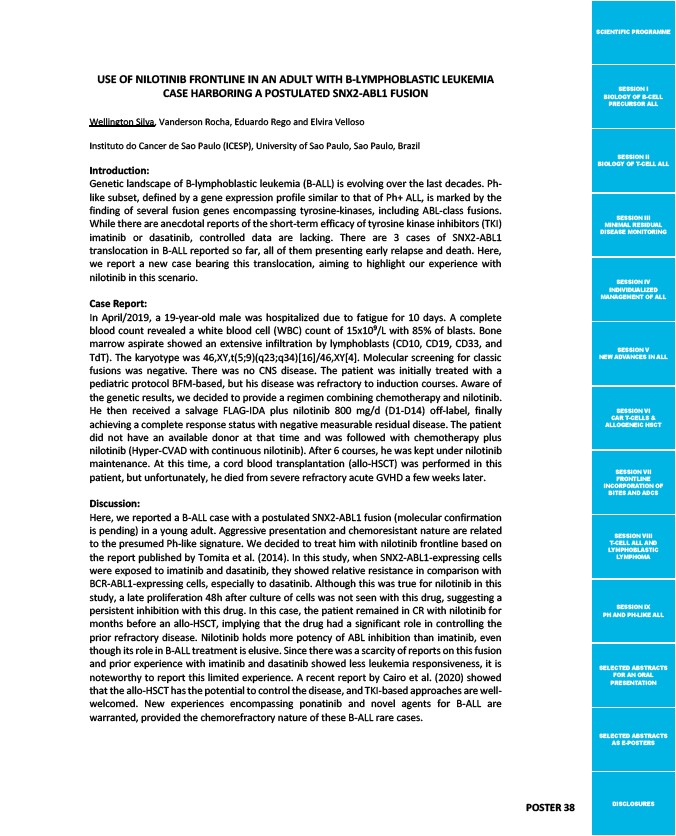
SCIENTIFIC PROGRAMME
SESSION I
BIOLOGY OF B-CELL
PRECURSOR ALL
SESSION II
BIOLOGY OF T-CELL ALL
SESSION III
MINIMAL RESIDUAL
DISEASE MONITORING
SESSION IV
INDIVIDUALIZED
MANAGEMENT OF ALL
SESSION V
NEW ADVANCES IN ALL
SESSION VI
CAR T-CELLS &
ALLOGENEIC HSCT
SESSION VII
FRONTLINE
INCORPORATION OF
BITES AND ADCS
SESSION VIII
T-CELL ALL AND
LYMPHOBLASTIC
LYMPHOMA
SESSION IX
PH AND PH-LIKE ALL
SELECTED ABSTRACTS
FOR AN ORAL
PRESENTATION
SELECTED ABSTRACTS
AS E-POSTERS
DISCLOSURES
USE OF NILOTINIB FRONTLINE IN AN ADULT WITH B-LYMPHOBLASTIC LEUKEMIA
CASE HARBORING A POSTULATED SNX2-ABL1 FUSION
Wellington Silva, Vanderson Rocha, Eduardo Rego and Elvira Velloso
Instituto do Cancer de Sao Paulo (ICESP), University of Sao Paulo, Sao Paulo, Brazil
Introduction:
Genetic landscape of B-lymphoblastic leukemia (B-ALL) is evolving over the last decades. Ph-like
subset, defined by a gene expression profile similar to that of Ph+ ALL, is marked by the
finding of several fusion genes encompassing tyrosine-kinases, including ABL-class fusions.
While there are anecdotal reports of the short-term efficacy of tyrosine kinase inhibitors (TKI)
imatinib or dasatinib, controlled data are lacking. There are 3 cases of SNX2-ABL1
translocation in B-ALL reported so far, all of them presenting early relapse and death. Here,
we report a new case bearing this translocation, aiming to highlight our experience with
nilotinib in this scenario.
Case Report:
In April/2019, a 19-year-old male was hospitalized due to fatigue for 10 days. A complete
blood count revealed a white blood cell (WBC) count of 15x109/L with 85% of blasts. Bone
marrow aspirate showed an extensive infiltration by lymphoblasts (CD10, CD19, CD33, and
TdT). The karyotype was 46,XY,t(5;9)(q23;q34)16/46,XY4. Molecular screening for classic
fusions was negative. There was no CNS disease. The patient was initially treated with a
pediatric protocol BFM-based, but his disease was refractory to induction courses. Aware of
the genetic results, we decided to provide a regimen combining chemotherapy and nilotinib.
He then received a salvage FLAG-IDA plus nilotinib 800 mg/d (D1-D14) off-label, finally
achieving a complete response status with negative measurable residual disease. The patient
did not have an available donor at that time and was followed with chemotherapy plus
nilotinib (Hyper-CVAD with continuous nilotinib). After 6 courses, he was kept under nilotinib
maintenance. At this time, a cord blood transplantation (allo-HSCT) was performed in this
patient, but unfortunately, he died from severe refractory acute GVHD a few weeks later.
Discussion:
Here, we reported a B-ALL case with a postulated SNX2-ABL1 fusion (molecular confirmation
is pending) in a young adult. Aggressive presentation and chemoresistant nature are related
to the presumed Ph-like signature. We decided to treat him with nilotinib frontline based on
the report published by Tomita et al. (2014). In this study, when SNX2-ABL1-expressing cells
were exposed to imatinib and dasatinib, they showed relative resistance in comparison with
BCR-ABL1-expressing cells, especially to dasatinib. Although this was true for nilotinib in this
study, a late proliferation 48h after culture of cells was not seen with this drug, suggesting a
persistent inhibition with this drug. In this case, the patient remained in CR with nilotinib for
months before an allo-HSCT, implying that the drug had a significant role in controlling the
prior refractory disease. Nilotinib holds more potency of ABL inhibition than imatinib, even
though its role in B-ALL treatment is elusive. Since there was a scarcity of reports on this fusion
and prior experience with imatinib and dasatinib showed less leukemia responsiveness, it is
noteworthy to report this limited experience. A recent report by Cairo et al. (2020) showed
that the allo-HSCT has the potential to control the disease, and TKI-based approaches are well-welcomed.
New experiences encompassing ponatinib and novel agents for B-ALL are
warranted, provided the chemorefractory nature of these B-ALL rare cases.
POSTER 38